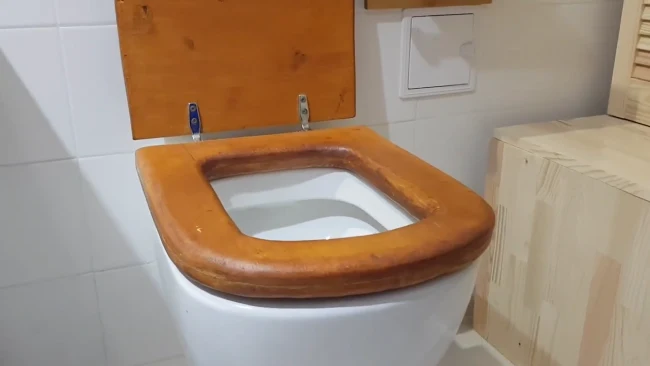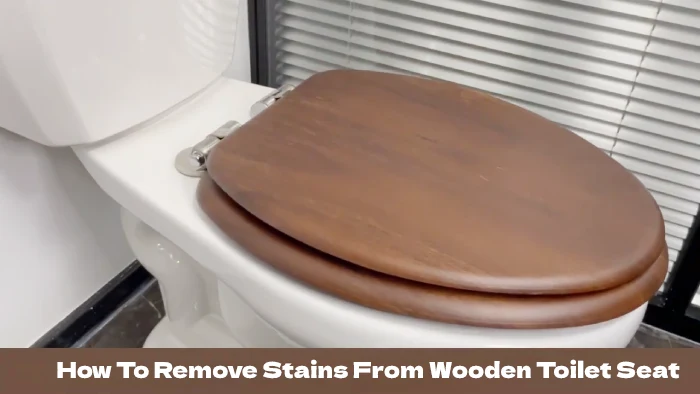Last Updated on October 18, 2023
Wooden toilet seats are prone to staining and discoloration over time. Not only can this be unattractive, but it can also lead to an unclean bathroom environment. Regular cleaning and maintenance are key to maintaining the luster of your wooden toilet seat.
You can use baking soda paste, vinegar, or commercial cleaning products to remove stains from a wooden toilet seat effectively. These cleaners aim to safely remove any unsightly marks without causing any damage or discoloration to the wood.
Let’s know how to safely remove them with easy-to-follow instructions without worrying about damaging or discoloring your toilet seat.
How to Remove Stains From Wooden Toilet Seats: Easy Methods

Wooden toilet seats are attractive and stylish but can also easily become stained over time. Regular cleaning and maintenance are essential to maintain its aesthetic appeal to remove any unattractive staining on the wooden toilet seat.
Check out these methods & steps:
Method 1: Baking Soda Paste
Expert cleaning results can be achieved by combining baking soda and manual scrubbing.
- To begin, create a paste of baking soda and water.
- Then, spread it liberally over the stained area on the wooden toilet seat and allow it to sit for 15 minutes.
- When the time is up, use an old toothbrush or other small brush to scrub away any residue that is left behind.
- Be sure to apply pressure and work in circular motions until all of the stains have been removed.
- Rinse off the surface with warm water before drying thoroughly with a soft cloth.
Method 2: Vinegar
When regular cleaners just won’t cut hard toilet stains, turn to the natural power of vinegar. Its organic components work wonders on stubborn toilet stains, making them a breeze to remove.
Here’s how to use it:
Step 1: Purchase Distilled White Vinegar
Distilled white vinegar is widely available in most grocery stores and can be purchased in different quantities, ranging from small bottles to larger containers. Buying enough to cover the task is important, as it can be difficult to acquire more once the cleaning process begins.
Step 2: Prepare the Wet Paper Towels
To prepare for cleaning, moisten a paper towel with distilled white vinegar. The paper towel should not be dripping wet but rather just damp enough to allow the vinegar to soak in.
Soak the paper towel in distilled white vinegar until it is slightly saturated to achieve this level of dampness.
Step 3: Cover the Toilet Seat
After the paper towels have been moistened with vinegar, you can use them to cover the toilet seat. You should apply the towels so they’re in full contact with the surface and overlap each other slightly.
Press down firmly on each towel so that it remains adhered to the seat for maximum effectiveness. Once the area is completely covered, it should be left undisturbed for at least 10 minutes so that the vinegar can work its magic on any stains present.
Step 4: Remove the Paper Towels and Scrub
After the allotted time has passed, wipe down the surface to remove dirt, grime, bacteria and other germs. Remove any wet paper towels from the toilet seat to do this effectively. Dispose of them appropriately.
After, use a soft sponge or toilet brush to scrub the seat. Vinegar can help loosen stains and make cleaning easier. Add some vinegar to a damp cloth and rub onto any stained areas before scrubbing. Rinse off with water and dry thoroughly with a clean towel or cloth.
Note: If you use commercial cleaners, follow the manufacturer’s instructions for best results.
What is the Reason for the Yellow Underside of the Wooden Toilet Seat?

A combination of hair product build-up, urine, fake tan, dead skin, mineral deposits, and certain cleaning products most likely causes the yellowing of wooden toilet seats.
- Hair product build-up can be caused by shampoos, soaps or other products used in the bathroom which contain oil or wax that accumulate over time.
- Urine is acidic and can cause wood discoloration if it is improperly cleaned.
- Fake tan lotions and spray tans can also stain the wood as they contain dyes that penetrate the wood’s surface.
- Dead skin cells and oils left behind from human contact can cause a yellowing effect on wooden surfaces over time.
- Also, mineral deposits from hard water or humid conditions can lead to discoloration of the wood surface.
Does bleach work on wooden toilet seats?
Using bleach on wooden toilet seats is not recommended, as it can cause discoloration and damage to the material. Bleach contains highly active ingredients that, when in contact with air, can cause the surface of the seat to turn yellow or even brown in some cases.
The harsh chemicals found in bleach can also break down the protective coating of an antibacterial-treated seat and weaken its structure over time. It is best to use alternative cleaning products that are safe for wood surfaces to clean a wooden toilet seat and maintain its integrity.
What kind of toilet seat doesn’t stain?
Your choice of toilet seat can significantly impact how easily it stains. In general, plastic toilet seats are more stain resistant than those made of enameled wood. Since they are lightweight and their finish is extremely durable, they are more resistant to wearing out, chipping, and staining than wood.
Additionally, plastic toilet seats are strong and long lasting, making them a good choice for those looking for a durable option that won’t stain easily.
Maintaining Wooden Toilet Seats: Get Stains Out

Take the appropriate steps to get rid of stains on wooden toilet seats. Though bleach may be effective on some materials, it should not be used on wooden toilet seats due to the risk of damaging the wood.
Instead, vinegar and soft cleaning cloths are recommended for removing dirt and grime. Regular maintenance, such as wiping down the seat with a damp cloth after each use, can help reduce staining.
Considering these measures can help maintain the appearance of your wooden toilet seat and keep it looking clean and pristine for years to come.

